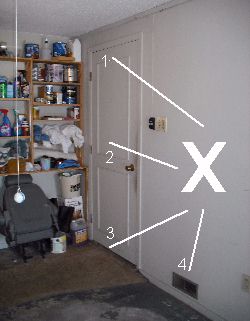Warning
Vents from the bathroom, clothes dryer or vacuum should NEVER be vented into the garage but to the exterior, to prevent exhaust fumes from entering the house.
Also:
Make sure that the drywall taping is in good condition. Often the drywall joints in the garage have only one coat over the taping. With high humidity levels in the garage the tape becomes loose allowing car fumes to enter the house. |
|
.
|
| Garage - Gas Proofing
|
|
| ...... |
Need more information? Use our search box
Gas-proofing garage. Automatic door closer.
A running car produces deadly exhaust fumes and building codes require that an attached garage must be gas-proofed to prevent the fumes from entering the house. This can be done by:
- Installing an automatic door closer on the interior garage door (man door) so that the door cannot be accidentially left open.
- Painting block walls adjacent to the house with an oil based paint. Standard cement blocks are porous.
- Sealing cracks and holes in walls and ceilings adjacent to the house.
- Placing foam gaskets behind switch and receptacle face plates.
- Caulking around hose bibbs and central vacuum outlets.
- Caulking around interior garage door frame and underneath the threshold.
- Weatherstripping the interior garage door.
The garage shown to the right was at one time converted into a bedroom and then back into a garage. As shown in the picture the garage is NOT gas proofed. The following steps should be taken to prevent carbon monoxide from entering the house.
1. Install an automatic door closer.
2. Replaced damaged hollow core door with a solid core or insulated steel door.
3. Install door sweep and weatherstripping.
|

Failing grade for gas proofing!!
|
| 4. Seal and remove former bedroom heat register. |
|
|